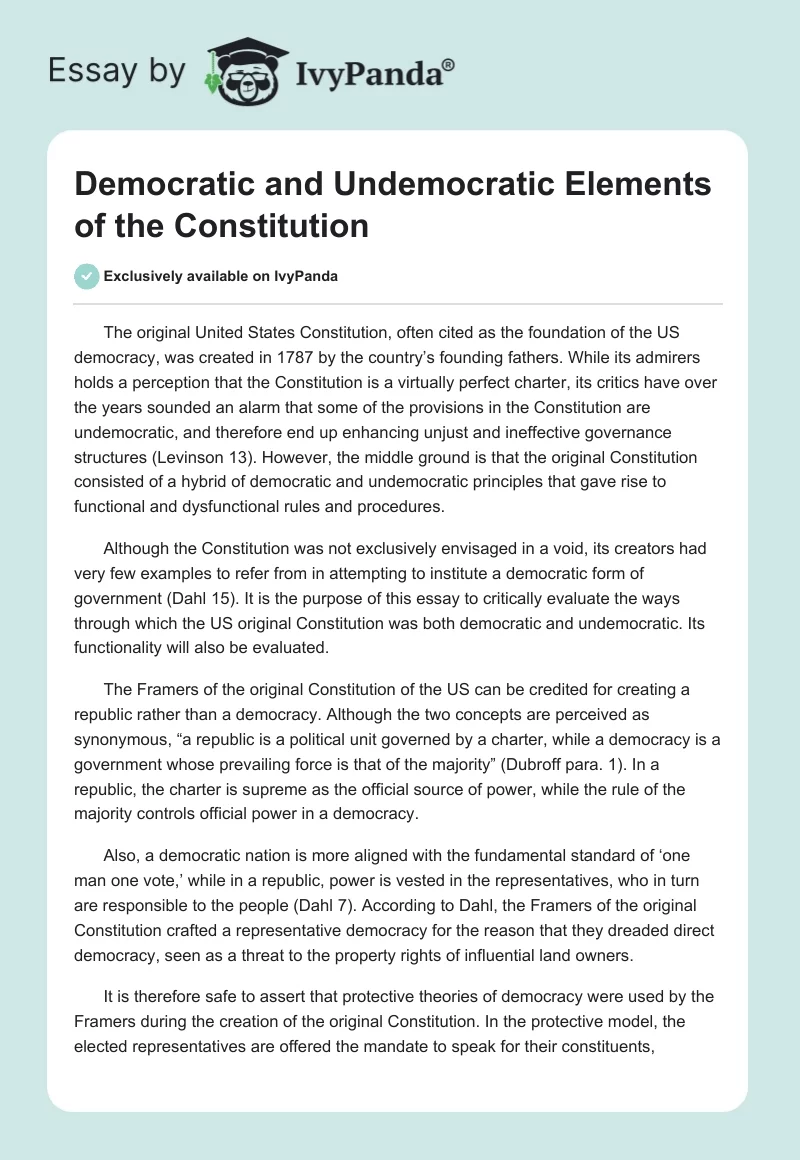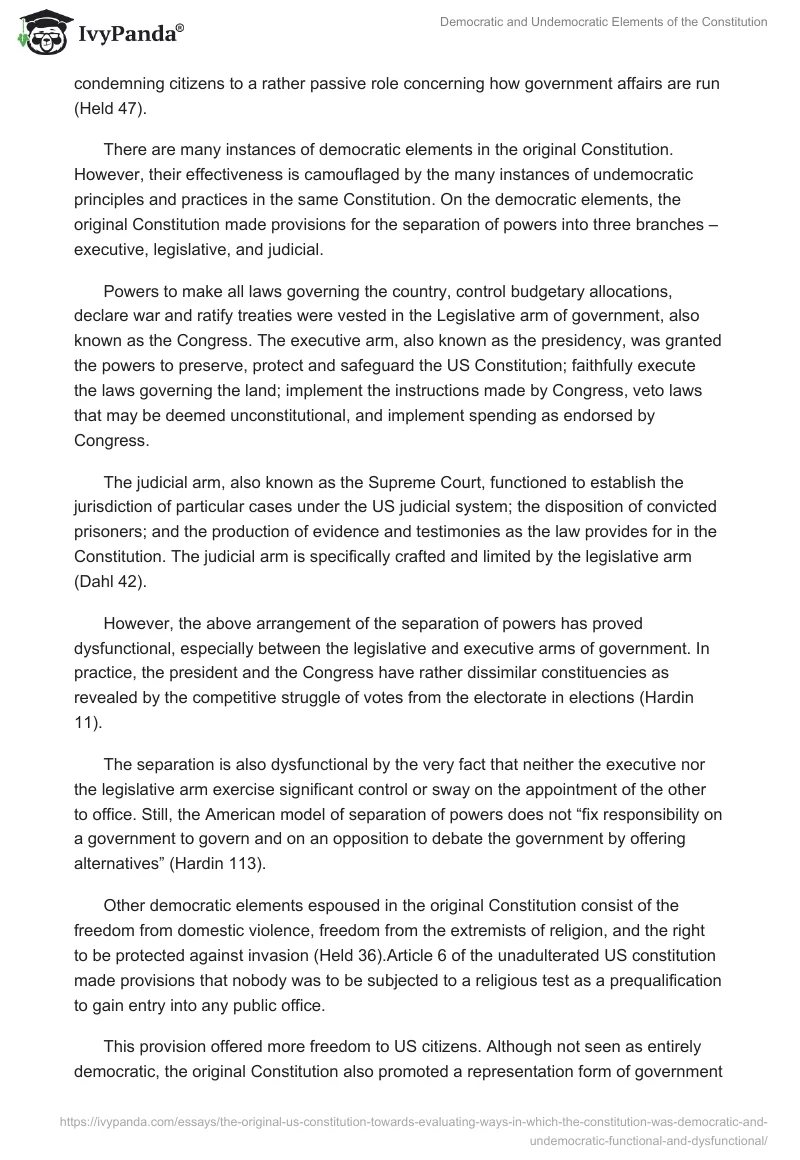The original United States Constitution, often cited as the foundation of the US democracy, was created in 1787 by the country’s founding fathers. While its admirers holds a perception that the Constitution is a virtually perfect charter, its critics have over the years sounded an alarm that some of the provisions in the Constitution are undemocratic, and therefore end up enhancing unjust and ineffective governance structures (Levinson 13). However, the middle ground is that the original Constitution consisted of a hybrid of democratic and undemocratic principles that gave rise to functional and dysfunctional rules and procedures.
Although the Constitution was not exclusively envisaged in a void, its creators had very few examples to refer from in attempting to institute a democratic form of government (Dahl 15). It is the purpose of this essay to critically evaluate the ways through which the US original Constitution was both democratic and undemocratic. Its functionality will also be evaluated.
The Framers of the original Constitution of the US can be credited for creating a republic rather than a democracy. Although the two concepts are perceived as synonymous, “a republic is a political unit governed by a charter, while a democracy is a government whose prevailing force is that of the majority” (Dubroff para. 1). In a republic, the charter is supreme as the official source of power, while the rule of the majority controls official power in a democracy.
Also, a democratic nation is more aligned with the fundamental standard of ‘one man one vote,’ while in a republic, power is vested in the representatives, who in turn are responsible to the people (Dahl 7). According to Dahl, the Framers of the original Constitution crafted a representative democracy for the reason that they dreaded direct democracy, seen as a threat to the property rights of influential land owners.
It is therefore safe to assert that protective theories of democracy were used by the Framers during the creation of the original Constitution. In the protective model, the elected representatives are offered the mandate to speak for their constituents, condemning citizens to a rather passive role concerning how government affairs are run (Held 47).
There are many instances of democratic elements in the original Constitution. However, their effectiveness is camouflaged by the many instances of undemocratic principles and practices in the same Constitution. On the democratic elements, the original Constitution made provisions for the separation of powers into three branches – executive, legislative, and judicial.
Powers to make all laws governing the country, control budgetary allocations, declare war and ratify treaties were vested in the Legislative arm of government, also known as the Congress. The executive arm, also known as the presidency, was granted the powers to preserve, protect and safeguard the US Constitution; faithfully execute the laws governing the land; implement the instructions made by Congress, veto laws that may be deemed unconstitutional, and implement spending as endorsed by Congress.
The judicial arm, also known as the Supreme Court, functioned to establish the jurisdiction of particular cases under the US judicial system; the disposition of convicted prisoners; and the production of evidence and testimonies as the law provides for in the Constitution. The judicial arm is specifically crafted and limited by the legislative arm (Dahl 42).
However, the above arrangement of the separation of powers has proved dysfunctional, especially between the legislative and executive arms of government. In practice, the president and the Congress have rather dissimilar constituencies as revealed by the competitive struggle of votes from the electorate in elections (Hardin 11).
The separation is also dysfunctional by the very fact that neither the executive nor the legislative arm exercise significant control or sway on the appointment of the other to office. Still, the American model of separation of powers does not “fix responsibility on a government to govern and on an opposition to debate the government by offering alternatives” (Hardin 113).
Other democratic elements espoused in the original Constitution consist of the freedom from domestic violence, freedom from the extremists of religion, and the right to be protected against invasion (Held 36).Article 6 of the unadulterated US constitution made provisions that nobody was to be subjected to a religious test as a prequalification to gain entry into any public office.
This provision offered more freedom to US citizens. Although not seen as entirely democratic, the original Constitution also promoted a representation form of government in which all constituents within the state had an opportunity to be represented in the Senate and House of Representatives.
There exists a multiplicity of undemocratic elements in the original US Constitution. First, although the original Constitution guaranteed freedom from domestic violence, it neither prohibited slavery nor sanctioned Congress to do so.
In essence, failure by the constitution to abolish slavery not only denied the legislative arm the power to forbid the importation of slaves prior to 1808, but it offered constitutional sanction to repressive laws such as the fugitive slave laws, which dictated that a fugitive slave had to be hunted down and taken back to the slave holder (Dahl 11).
The slavery perspective reveals a dysfunctional Constitution in the sense that its preamble had sought to establish justice and blessings of liberty (Levinson 13).
Second, the original Constitution was unsuccessful in assuring the right of suffrage, leaving the interpretations and qualifications of suffrage to individual states (Dahl 12). This inherently meant that half of the population, mostly women, African-Americans, and poor Native Americans could not vote in an election.
By then, the Constitution had suppressed the civil liberties of these groups of Americans. However, the same civil liberties, under the auspices of civil rights groups, were instrumental in campaigning for the rights of the women to vote a century and half later. Voting privileges for African-Americans were attained some two centuries later, courtesy of the same civil rights groups led by astute rights activists such as Malcolm X and Martin Luther King (Hardin 38).
It is therefore safe to ascertain that the extent to which the civilians’ voices or inputs in the public field are subdued or are permitted to be heard have fundamental implications on whether the answerability and responsibility essential for government effectiveness will be created (Pritchet & Kaufman para. 1).
Third, by coming up with a system of electing a president that was to be shielded from both the desires of popular majorities and the overbearing influence of congressional control, the Framers of the original Constitution probably never stopped to ponder the contour that politics would assume in a mature democratic republic.
Consequently, the Framers hatched the Electoral College, a group of presidential electors comprising men of outstanding wisdom, character and value, charged with the responsibility of choosing the president (Dahl 15). Through this provision, the US is often led by unpopular and incompetent presidents, who have lost the popular vote but goes ahead to be chosen by the Electoral College.
Indeed, the Electoral College was conceived to bring the small states on board in the process of forming a federal government. Federalism, which is defined as a structure of government in which authority and power is distributed between a national government and constituent regional governments, has obvious advantages of guaranteeing government services remain closer to the people, decentralizing resources, enhancing exclusive and innovative techniques for tackling issues bedeviling society at a regional level, and providing safeguards to the domination by the majority. However, it leads to duplication of government services, overlapping policies, inequality between regions and corruption (Johnson 13).
This not withstanding, the Electoral College in the 21st century has served to curtail participatory and pluralist democracy, with small states such as Wyoming and North Dakota having equal votes in the college with highly populated states such as California. This reveals the dysfunctional nature of the original constitution.
Forth, the original Constitution failed to curtail the power enjoyed by the judiciary to proclaim as unconstitutional statutes that had been aptly approved by the Congress and duly signed by the sitting president (Dahl 18). Again, this reveals a dysfunctional aspect of the original Constitution in the fact that federal judges assumed the responsibility of formulating government laws and policy frameworks, a task that undoubtedly belonged to the Congress.
The method used to select senators and the issues of equal representation in the senate are other sticky issues found in the original Constitution. Senators were to be chosen by the state legislatures rather than the constituents, effectively curtailing participatory democracy and a rule by the majority since the selected senators would be minimally receptive to popular majorities and conceivably be more receptive to the requirements of property holders (Dahl 16).
This is both undemocratic and dysfunctional. In equal representation, the senate tied American voters to geographical attributes rather than population densities, effectively tilting political power in the direction of the alliances of smaller states. This is undemocratic.
All in all, the original Constitution has had its fair share of democratic and undemocratic elements, as well as supporters and detractors. In 2000, Americans were ruled by an unpopular president in the name of George W. Bush as a direct result of the Constitution’s shortcomings.
What alarms many experts and policy makers is the fact that it is extremely hard to change some offending provisions in the US constitution. The American people never took part in a referendum to ratify the Constitution. In the light of this, concerted efforts need to be initiated to ensure that the US constitution represents the true value of democracy – rule by the majority.
Works Cited
Cunningham, F. Theories of Democracy: A Critical Introduction. London: Routledge. Web.
Dahl, R.A. (2002). How Democratic is the American Constitution, 2nd Ed. Yale University Press. 2002. Web.
Dubroff, M.D. What is the difference between a Republican and a Democracy? 2009. Web.
Hardin, C.M. The Separation of Power needs Major Revision. In: R.A. Goldwin & A.
Kaufman, Separation of Powers — Does it Still Work? American Enterprise Institute. 1986. Web.
Held, D. Models of Democracy, 2nd Ed. Stanford University Press. 1997. Web.
Johnson, K.S. Governing the American State: congress and New Federalism, 1877- 1929. New Jersey: Princeton University Press. Web.
Levinson, S. Our Undemocratic Constitution: Where the Constitution goes wrong and how we the People can correct it. New York NY: Oxford University Press. 2008. Web.
Pritchet, L., & Kaufman, D. Civil Liberties, Democracy, and the Performance of Government Projects. 1998. Web.


